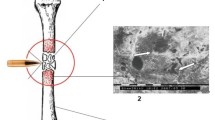Abstract
The bending of the tibiae of dogs and rabbitsin vivo was studied. A new physical method (margin of errors less than 1%) which gives readily reproducible values of bone stability is reported. The results of bending stiffness, measuredin vivo andin vitro, were nearly identical only if the extremities were slim. If thick, soft parts in the measuring area were present, different loading values followed the same bending. A formula to correct the influence of the soft parts (skin, muscles and tendons) was proposed. The true bending stiffness was determined with the aid of thein vivo values without having to measure the exposed bone afterwards. Comparisons of measurements showed that the values found with the formula reflected the true bending stiffness in a range of errors between 0.3 and 10.5%. A load of 4700±710 g gave a true bending stiffness of 0.1 mm and of a bone area of 1.0 cm2.
Résumé
La courbure des tibias de chiens et de lapins a été étudiéein vivo. Une nouvelle méthode physique (avec une marge d'erreur inférieure à 1%) donne des valeurs de stabilité osseuse aisément reproductibles. Les résultats de rigidité de courbure, mesuréein vivo etin vitro, sont trés voisins lorsque les extrémités sont minces. Lorsqu'elles sont épaisses, des tissus mous sont présents dans la région à tester et différentes valeers de charges suivent la même courbure. Une formule pour compenser l'effet des tissus mous (peau, muscles et tendons) est proposée. La rigidité vraie de courbure est déterminée à l'aide des valeursin vivo sans devoir mesurer par la suite l'os mis à nu. La comparaison des mesures montrent que les valeurs obtenues à l'aide de la formule traduisent la rigidité vraie de courbure avec une marge d'erreurs de 0,3 à 10,5%. Une charge de 4700±719 g donne une rigidité vraie de courbure de 0,1 mm, d'une surface osseuse de 1,0 cm2.
Zusammenfassung
Die Beugung von Hunde- und Kaninchen-Tibias wurdein vivo untersucht. Eine neue einfache physikalische Methode (Fehlergrenze weniger als 1%), welche reproduzierbare Werte der Knochenstabilität vermittelt, wurde dabei angewandt. Die Resultate der Beugungs-Steifheit, welchein vivo undin vitro gemessen wurde, zeigten nur dann fast identische Werte, wenn die Extremitäten dünn waren. Sobald dicke, weiche Stellen im gemessenen Bereich vorhanden waren, erfolgten bei der gleichen Beugung unterschiedliche Belastungswerte. Es wird eine Formel vorgeschlagen, die den Einfluß der weichen Stellen (Haut, Muskeln und Sehnen) korrigieren soll. Die richtige Beugungs-Steifheit wurde mit Hilfe derin vivo-Werte bestimmt, ohne daß nachher der freigelegte Knochen gemessen werden mußte. Vergleichende Messungen zeigten, daß die mit dieser Formel gefundenen Werte die richtige Beugungs-Steifheit mit einer Fehlergrenze zwischen 0,3 und 10,5% wiedergaben. Eine Belastung von 4700±710 g ergab die korrekte Beugungs-Steifheit von 0,1 mm in einem Knochenbereich von 1,0 cm2.
Similar content being viewed by others
References
Bell, G. H., Cuthbertson, D. P., Orr, J.: Strength and size of bone in relation to calcium intake. J. Physiol. (Lond.)100, 299–317 (1941).
Currey, J. D.: The effect of protection on the impact strength of rabbit's bones. Acta anat. (Basel)71, 87–92 (1968).
Dempster, W. T., Coleman, R. F.: Tensile strength of bone along and across the grain. J. appl. Physiol.16, 355–360 (1960).
Evans, F. G., Pedersen, H. E., Lissner, H. R.: The role of tensile strength in the mechanism of femoral fractures. J. Bone Jt Surg. A33, 485–501 (1951).
Evans, F. G.: Methods of studying the biomechanical significance of the bone form. Amer. J. phys. Anthrop.11, 413–436 (1953).
Sedlin, E. D., Hirsch, C.: Factors affecting the determination of the physical properties of femoral cortical bone. Acta orthop. scand.37, 29–48 (1966).
Semb, H.: The breaking strength of normal and immobilized cortical bone from dogs. Acta orthop. scand.37, 131–140 (1966).
Weir, J. B. de V., Bell, G. H., Chambers, J. W.: The strength and elasticity of bone in rats on a rachitogenic diet. J. Bone Jt Surg. B31, 444–451 (1949).
Author information
Authors and Affiliations
Rights and permissions
About this article
Cite this article
Hernández-Richter, H.J., Benfer, J. & Struck, H. Experimental studies on fracture-healing. Calc. Tis Res. 13, 11–18 (1973). https://doi.org/10.1007/BF02015391
Received:
Accepted:
Issue Date:
DOI: https://doi.org/10.1007/BF02015391




